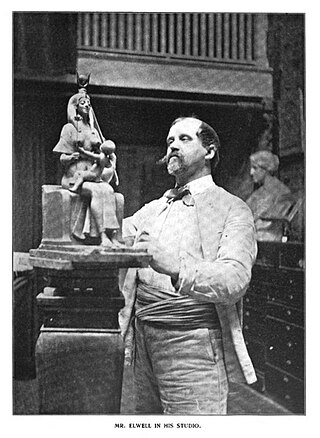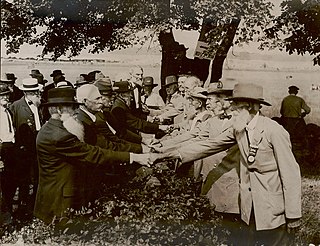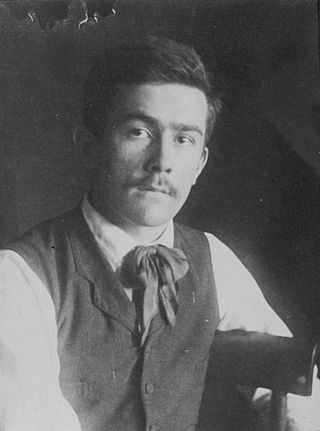
Jakob Otto Schweizer (March 27, 1863, Zurich - 1955) was a Swiss-American sculptor noted for his work on war memorials.

Jakob Otto Schweizer (March 27, 1863, Zurich - 1955) was a Swiss-American sculptor noted for his work on war memorials.
Born in Zurich, Switzerland, Schweizer enrolled in that city's Industrial Art School in 1879. In 1882, he entered the Dresden Academy of Fine Arts in Dresden, Germany, where he studied with Johannes Schilling. [1] He then lived in Florence, Italy, 1889-94. He arrived in New York City in 1894, and settled in Philadelphia the following year. [2]
He was a member of Philadelphia's German Society of Pennsylvania, and through its connections he obtained his first major commission, a bronze statue of General John Peter Gabriel Muhlenberg (1910–11). He was also a Freemason. [3]
Schweizer created 7 sculptures for the Gettysburg Battlefield, more than any other artist. Among these was a larger-than-life statue of Abraham Lincoln for the Pennsylvania State Memorial. He modeled another Lincoln statue for the Memorial Room at the Union League of Philadelphia, and flanked it with 8 portrait reliefs of Union officers. [4] His only equestrian statue, Baron von Steuben (1921), is in Milwaukee. He modeled dozens of busts, bas-reliefs and medallions, [5] and exhibited at the 1916 continuation of the Panama–Pacific International Exposition in San Francisco. [6]
His All Wars Memorial to Colored Soldiers and Sailors (1934), originally placed in Philadelphia's Fairmount Park, was relocated to Logan Square in 1994.
Schweizer died in 1955, at the age of 92.




Edward Clark Potter was an American sculptor best known for his equestrian and animal statues. His most famous works are the marble lions, nicknamed Patience and Fortitude, in front of the New York Public Library Main Branch

William Rudolf O'Donovan was an American sculptor.

Charles Henry Niehaus was an American sculptor.

George Edwin Bissell was an American sculptor.

James Edward Kelly was an American sculptor and illustrator who specialized in depicting people and events of American wars, particularly the American Civil War.

Franklin Bachelder Simmons was a prominent American sculptor of the nineteenth century. Three of his statues are in the National Statuary Hall Collection, three of his busts are in the United States Senate Vice Presidential Bust Collection, and his statue of Ulysses S. Grant is in the United States Capitol Rotunda.

Francis Edwin Elwell was an American sculptor, teacher, and author.

The 1913 Gettysburg reunion was a Gettysburg Battlefield encampment of American Civil War veterans for the Battle of Gettysburg's 50th anniversary. The June 29 – July 4 gathering of 53,407 veterans was the largest Civil War veteran reunion. All honorably-discharged veterans in the Grand Army of the Republic and the United Confederate Veterans were invited, and veterans from 46 of the 48 states attended.

Joseph Alexis Bailly was an American sculptor who spent most of his career in Philadelphia, Pennsylvania. He taught briefly at the Pennsylvania Academy of the Fine Arts, which has a collection of his sculpture. His most famous work is the statue of George Washington in front of Independence Hall.

Henry Kirke Bush-Brown was an American sculptor and the adopted nephew of sculptor Henry Kirke Brown. He was raised in Newburgh, New York and attended the National Academy of Design in New York City. He became known for historically accurate realist sculptures illustrating American history.

Samuel Aloysius Murray was an American sculptor, educator, and protégé of the painter Thomas Eakins.

The George Gordon Meade Memorial, also known as the Meade Memorial or Major General George Gordon Meade, is a public artwork in Washington, D.C. honoring George Meade, a career military officer from Pennsylvania who is best known for defeating General Robert E. Lee at the Battle of Gettysburg. The monument is sited on the 300 block of Pennsylvania Avenue NW in front of the E. Barrett Prettyman United States Courthouse. It was originally located at Union Square, but was removed and placed in storage for fourteen years before being installed at its current location. The statue was sculpted by Charles Grafly, an educator and founder of the National Sculpture Society, and was a gift from the state of Pennsylvania. Prominent attendees at the dedication ceremony in 1927 included President Calvin Coolidge, Governor John Stuchell Fisher, Secretary of the Treasury Andrew W. Mellon, and Senator Simeon D. Fess.

The Pennsylvania State Memorial is a monument in Gettysburg National Military Park that commemorates the 34,530 Pennsylvania soldiers who fought in the July 1 to 3, 1863 Battle of Gettysburg during the American Civil War. The memorial stands along Cemetery Ridge, the Union battle line on July 2, 1863. Completed in 1914, it is the largest of the state monuments on the Gettysburg Battlefield.

Karl Gerhardt (1853-1940) was an American sculptor, best known for his death mask of President Ulysses S. Grant and a portrait bust of Mark Twain.

Frederick Cleveland Hibbard was an American sculptor based in Chicago. Hibbard is best remembered for his Civil War memorials, produced to commemorate both the Union and Confederate causes.

William Clark Noble was an American sculptor best known for his monuments.

Henry Jackson Ellicott was an American sculptor and architectural sculptor, best known for his work on American Civil War monuments.
![]() Media related to J. Otto Schweizer at Wikimedia Commons
Media related to J. Otto Schweizer at Wikimedia Commons